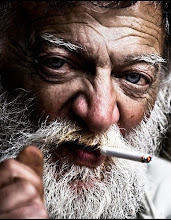Friday, September 19, 2008
Arrival in Santiago!
The final days of walking were very picturesque, passing through rolling green fields and heather covered hills. The similarities to Ireland were amazing, not just in the landscape but also in the music and lifestyles. Gone were the continental style bars and cafes we had seen in Navarra, La Rioja and Castillia y Leon, the bars in Galicia resembled Irish pubs, with warm welcoming fires, hearty stews and traditional music.
Perhaps the nicest albergue we stayed in during the last quarter of the hike was in Ribadiso, just a few kms short of Arzua. Housed in a refurbished traditional pilgrims hospice it is located along the banks of the Iso river, perfect for soaking sore feet after a long day!
We walked the last 15km to Santiago with a lovely Irish woman from Co Down, Irene. We left here at the office where pilgrims receive their compostella, as she had planned to take the train to Madrid that night so we were surprised to meet her the next morning in front of the cathedral. Apparently not long after we had left her, she had taken rather poorly and had to go to hospital. The doctors diagnosed a form of gastroenteritis which is quite common among pilgrims. Luckily one of the women who work in the compostella office took her to her own house after the hospital where she was able to recuperated and she seemed in good form as we waved her off to the train station.
A large number of pilgrims we met along the route, especially the last stages, were suffering from stomach problems. This is not really surprising when one considers that the municipal albergues in Galicia are often very dirty, in particular those at Palas de Rei and Arca. I'm sure not too many pilgrims would mind paying an extra 50 cent per night if it meant that the albergues were properly cleaned and stocked with toilet paper and soap.
Thankfully no major bedbug sightings to report in Galicia, perhaps the colder climate isn't to their liking or maybe we were just very lucky. If I have time next week I'll write a post dedicated soely to the little critters, outling the does and don't and the hard lessons we learned along the way.
Now back in Ireland, we'll have time to upload some more photos but not just now, tomorrow we are off for a week long tour with Anna's parents, down the west and southern coasts, from Westport to Cork and back up again, by car thankfully, we have to give our feet time to recover!
Slán go fóill.
Monday, September 8, 2008
Day 26


This was to be our hardest day but we were both surprised how easy it was {My apologies to David and Nora who had found it to be the most difficult stage, but bear in mind that we took we took a rest day in Astorga!}. The trail climbs from about 500m up to a height of 1,300m at the end of a 30km hike through a river valley, which sounds harder than it actually is. The scenery through the valley was amazing and the final push to the top wasn't too difficult, probably owing to our 3 years of hiking mountains in Korea.
The weather is definitely as lot colder and wetter in Galicia, more in tune with Ireland than Spain. Today is our final planned rest day before we hike the final 5 days to Santiago. We are both in good shape, Anna's blisters are getting better, there hasn't been a bed bug attack in a few days and I've thankfully not had any cramping of late. Both of us do have stomach bugs however, so the rest day is definitely well timed! Neither of us have any appetites which is a bit of a problem when we need to be taking on at least 3000 calories per day while walking! Last night we stayed in a fantastic albergue in a private house called Don Alvaro. Tonight we will probably stay in a private room however, to make sure we get a proper nights rest before tomorrow.
Yesterday's walk from Tricastella to Sarria was spectacular, starting off through a river valley and passing through abandoned hamlets perched on hillsides. Sarria itself is a bit of a one horse town, the only reason it is popular is because it is 117km from Santiago. In order to get your compostella, certificate of completion in Santiago, you have to have walked at least the final 100km. Thus the town is full of scout groups, church groups and other ne'er do wells. Full of first day enthusiasm they all woke up a 5am this morning, fumbling around in the dark, trying to pack their bags, while veterans like Anna and I looked on in dozy amusement!
Fingers crossed our bugs will be gone today, we'll have a big dinner and be on our way tomorrow, arriving in Santiago on the 14th.
Hasta luego
Saturday, August 30, 2008
Day 16


Here are a couple of pictures of past parades.


In the above photo note the crazed expressions on the statues in the background. That seemed to be par for the course; part KKK rally, part zombie freak show.
Unfortunately we arrived too late in the weirdo season for this year´s parade but the promo poster for 2009 looks great!

Just to add to the atmosphere we spent the night at the Santa Cruz convent of the Benedictine nuns. The convent itself is in a beautiful 17th century building next to the crumbling San Tirso church.

In order to stay at convents and monasteries along the route you must be walking or cycling to Santiago and you must be in possession of a document called a credencial. Thus you usually share accomodation with like minded people; religous zelets, rosy cheeked backpackers etcetera etcetera. So you can imagine our surprise when we returned to the convent from a trip to the store to find the dodgiest, meanest, scariest looking druggie you have ever seen greet us at the door.
Druggie: Welcome pilgrims!
Us: Gulp.
(File photo)

As welcoming and hospitable as the nuns are, they aren´t getting any younger. In fact, the median age for the convent was 82 (including Anna and I). Thus one of them had granted admittance to this savory character who could not produce a credential, nor passport, nor ID of any form and as it turned out, couldn´t tell us where he had stayed the previous night or indeed where he was going. The only sense that we could make from his ramblings was that the church is evil and the Knights Templar protected a great secret. At first we thought he may have been a latter day prophet but then we realised he was just recounting the plot of The DaVinci Code.
Needless to say we all had a pleasant nights sleep, holding our valuables under our pillows and keeping one eye on the nutjob.
I´ll keep an eye on the Interpol webiste for the next couple of weeks.
Thursday, August 28, 2008
Day 13.

We spent last night in a 13th century convent in Carrion de los Condes. It was a fantastic place except that Anna got bitten by bed bugs again, just when her previous bites were beginning to heal! Her allergic reaction to the bites is quite severe and causes blisters and blood and combined with a stomach bug I picked up yesterday, today we will only travel about 15km to Sahagun and take a rest this afternoon.


Apart from those few setbacks, everything is going really well. The walking is quite easy, no major injuries and the countryside is very pretty. The food is quite varied, ranging from inedible to passable. How we both long for some kimchi!
After that we should be able to finish by about the 14th/15th of September and fly back to Ireland on the 16th.
Hasta luego!
Wednesday, August 20, 2008
4 days in.
When we first arrived in Pamplona on the 14th we were really surprised by how bloody cold it was (about 15 degrees). Also we hadnt prepared for the fact that the 15th was the Feast of the Assumption so everything was closed. Finding an open shop in Spain is difficult at the best of times, but during a holiday only Chinese 1 Euro stores and Pakistani run convenience stores are open. Thus on our first day, we feasted on chocolate bars and kept warm with Asian made scarves. Welcome to a religious holiday in Spain in August!
The next morning we started hiking early, about 5.30am and knocked off 22km at a fairly brisk pace, mainly because we were so cold but also due to our first day enthusiasm. We arrived at our destination at about 11am, had a look around the lovely old town and checked into our hostel. Being a private hostel, it cost slightly more (E8) than the municipal hostel but it did have a swimming pool which provided a nice respite for tired muscles.
Day 2 saw us do about another 22km this time and brought us to Estella. On the route we passed through many beautiful hilltop villages whose appearances haven´t changed much over the last 5oo years. Unfortunately at about 1am that night, I was awoken by Anna who had spotted about a dozen bed bugs crawling over my body. While this is disturbing on it´s own, what is worse is the fact that Anna is highly allergic to bed bugs, having had a nasty experience with them in Paris. However, considering the time and the place (municipal hostel, no other beds available) we killed as many as we could (great fun) and tried to get back to sleep. The next morning we counted over 20 bites on Anna which swelled and blistered over the coming day leaving her looking more like a 14th century leaper than a 21st century hiker.
On day 3 we picked up some antihistamine cream and tablets for Anna´s sore which at this stage had festered blistered and left her in quite a lot of pain. Added to this were blisters on her feet and when we arrived in the town of Los Arcos both of us were starting to feel the strain on our bodies. We were fortunate enough to arrive in Los Arcos during the annual festival. We got to eat some regional specialities with the locals and even participate in some bull running!
Day 4 was the longest so far, totalling about 30km. The first 20 went smoothly enough but by the last 10 were hard going. Anna´s blisters were aching and my thighs started to cramp up and the final 6km to Logrono were some of the most painful I´ve ever experienced. Even with stretching and isotonic drinks the cramps got worse causing me to put more weight and pressure on my lower legs, which in turn caused more cramps and pain. Arriving in the Logrono we decided to check into a small hotel just to have hot showers and a decent nights sleep. It worked a treat and today Anna´s blisters and bites are receding and I can feel something from my waist down!
Day 5, today is our designated rest day. Rather than trying to go two 30km days in a row we decided to stop here and get Anna´s sores cleaned by a doctor. This morning however, they are looking much better so we have spent the day wandering around the historical town centre.
So far the food outside the major towns has been pretty dire. Fruit and veg is scarce and evening meals of greasy meats and chips don´t provide the substance needed for a 800km hike. We have on occasion cooked for ourselves (some but not all hostels have a basic kitchen), dishing up huge plates of carbohydrates and desserts of fresh fruit, if available.
In general though we are enjoying ourselves immensely. No serious injuries to report although Anna´s encounter with the bed bugs was pretty harsh. Tomorrow is a long day but we will be fine after our days rest.
Internet cafes are scarce on the ground. This post is being made in some kind of immigrant welfare centre so I better sign off as Bedatura from Eritrea wants to use the computer.
Hasta luego.
Wednesday, July 23, 2008
T minus 3 weeks.
Our preparations have been going quite well. Not having to be at school until 4pm on weekdays has helped a lot.
The monsoon season is in full swing and there have been perhaps 4 dry days in the last two weeks.
On those days we have managed to get out for a hike up Cheongaesan, Gwanaksan and yesterday Samsungsan.
On Monday we went to Dongdaemun and visited about 15 hiking stores and picked up a couple of backpacks. Anna's is 35 liters and mine is 45.
More later.
Sunday, July 6, 2008
Cheonggyesan
South of Umyonsan and west of Gwanaksan lies Cheonggyesan (Clear Stream Mountain 618m).Although not as famous (or busy) as Gwanaksan, it offers a gentler if longer hike.
 Beginning near Yangjae, it is a steady climb up forested trails and wooden steps (over 1400 of them) to ridge line at about 580 meters
Beginning near Yangjae, it is a steady climb up forested trails and wooden steps (over 1400 of them) to ridge line at about 580 meters
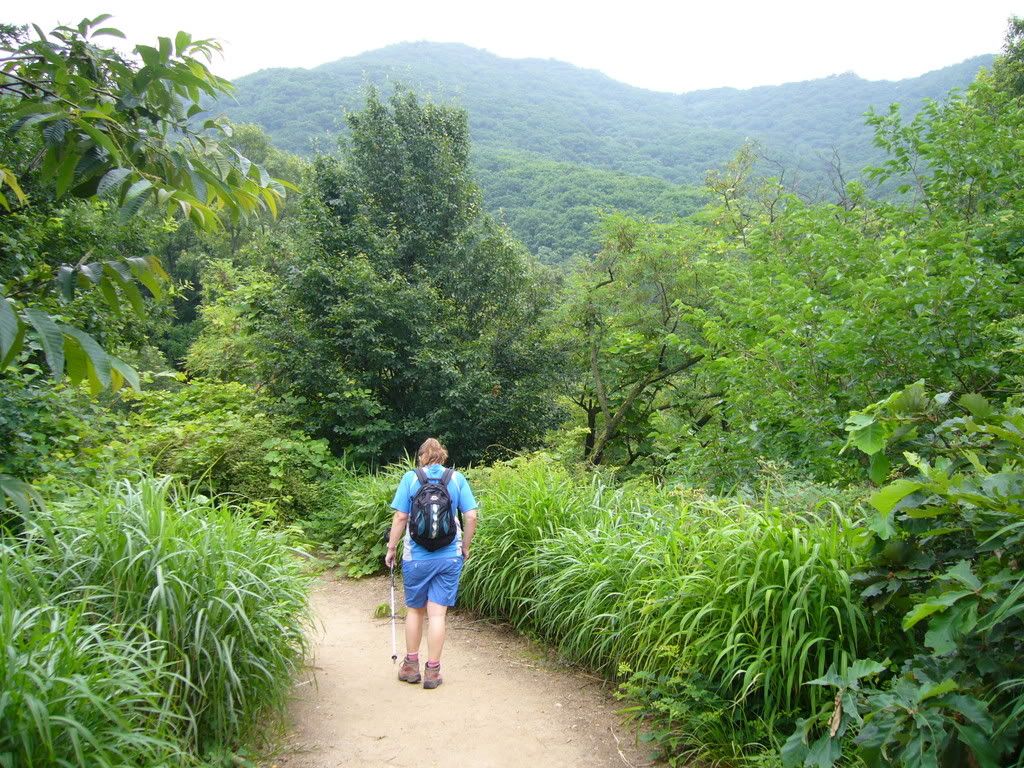
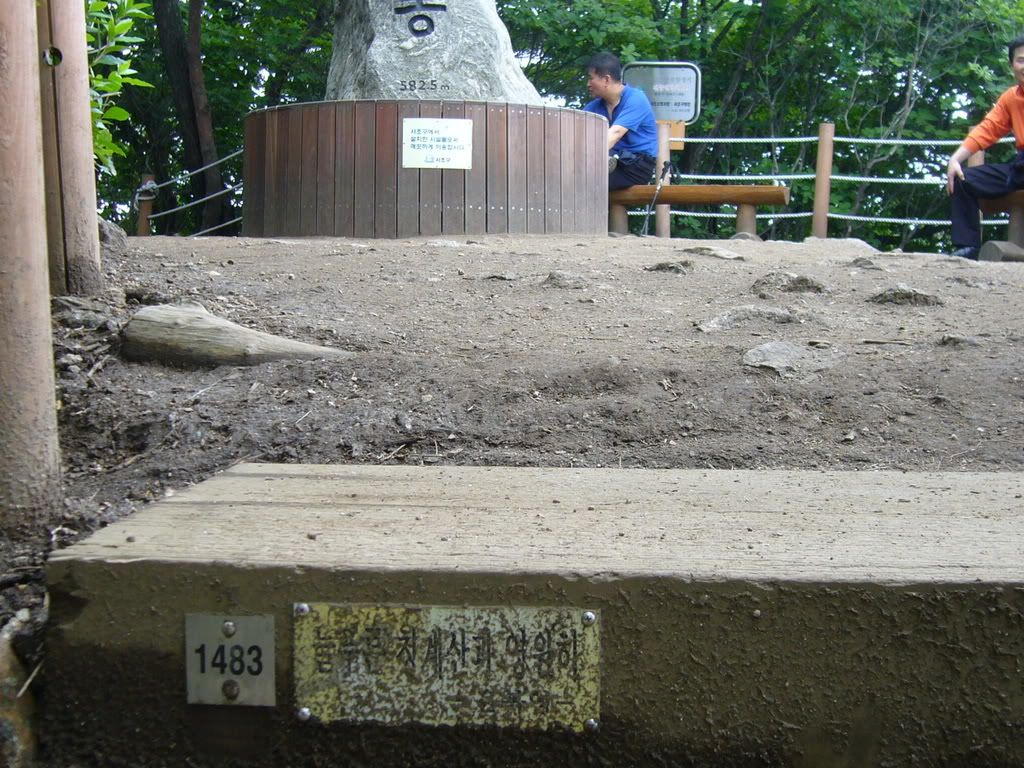
On the northern slopes is a memorial to 53 members of the 250th special air operations training course who were killed here on June 1st 1981. While trying to land at an airstrip in Geoyeo dong, their C-123 crashed into Cheonggyesan in dense fog killing all on board.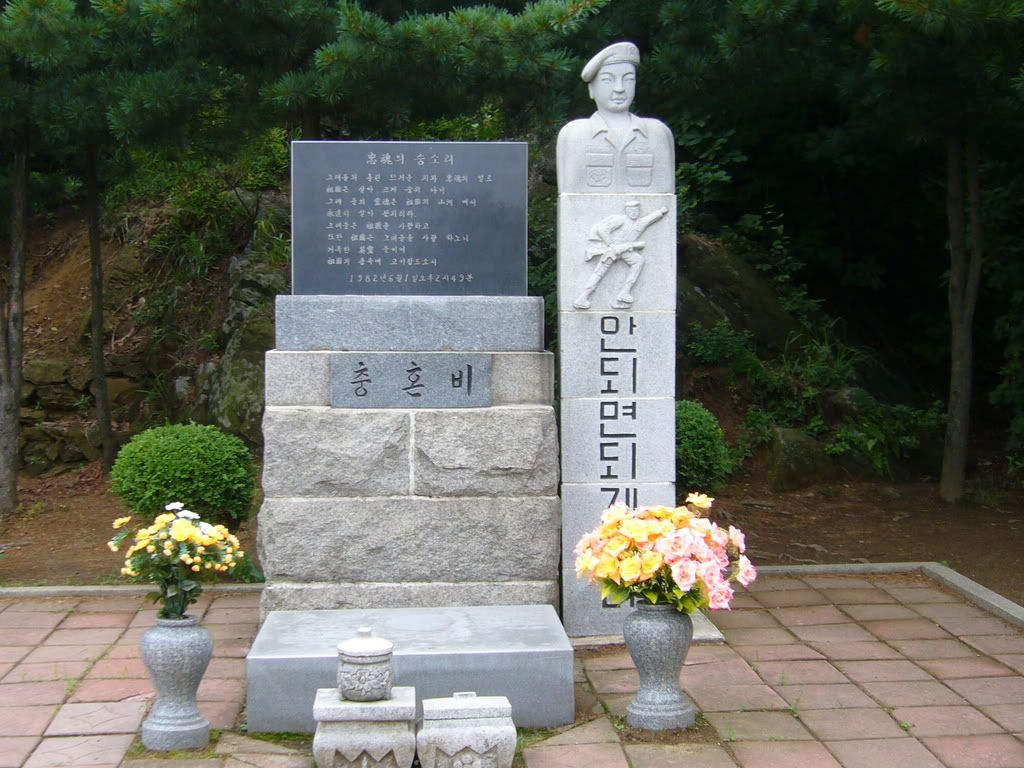
As is the norm for mountains in this are the top is occupied by the military meaning a long laborious detour around the peak. 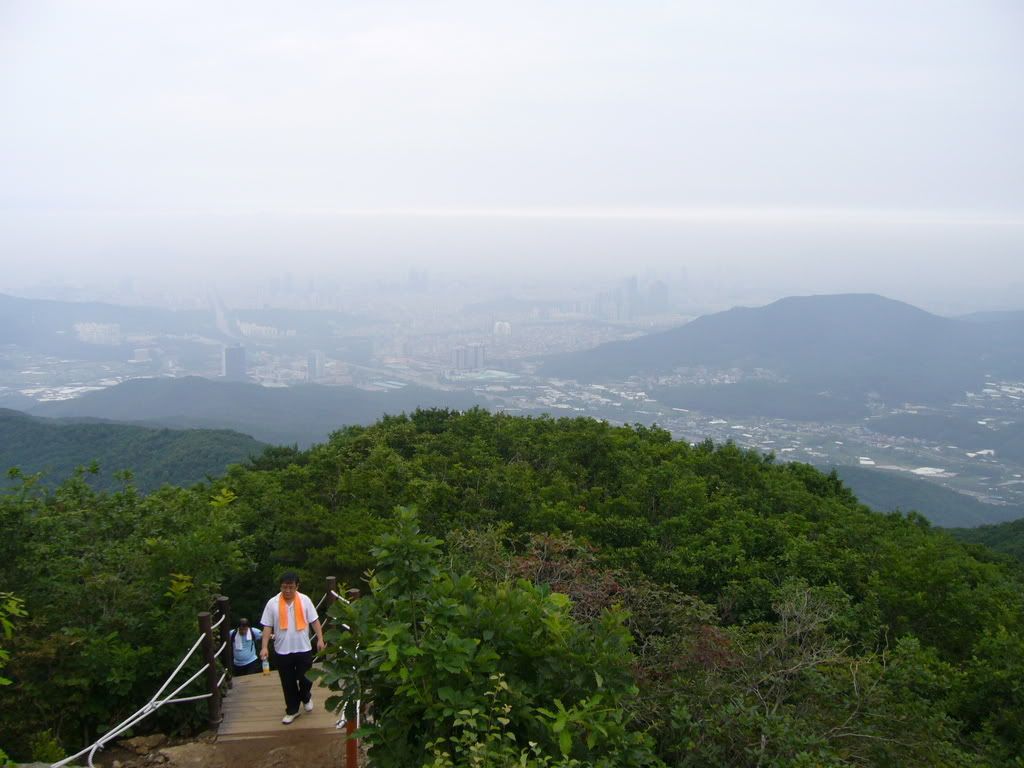
Near the peak is a large bolder, Manggyeongdae. With the establishment of the Joseon Dynasty (1392 - 910) an advisor to the fallen Goryeo Dynasty(918 ~1392) Jo Yun took refuge here and sulked for a while, unwilling to accept his new rulers (Coupled with the story of the grumpy princes doing a similar thing on Gwanaksan, I'm starting to see a pattern emerging here. I wish some of my grumpy and indignant 3rd graders would take after their ancestors and clear off to a mountain for a few years). Having a clear view over Umyeonsan and across the Han river into Seoul, Jo Yun named this boulder Manggyeongdae.
On the southern side is the famed temple of Cheonggyesa. Established during the Silla Dynasty (57 BCE – 935 CE)and restored in 1284 in is similar to many Joseon era temples with the notable exceptions of it's large reclining Buddha.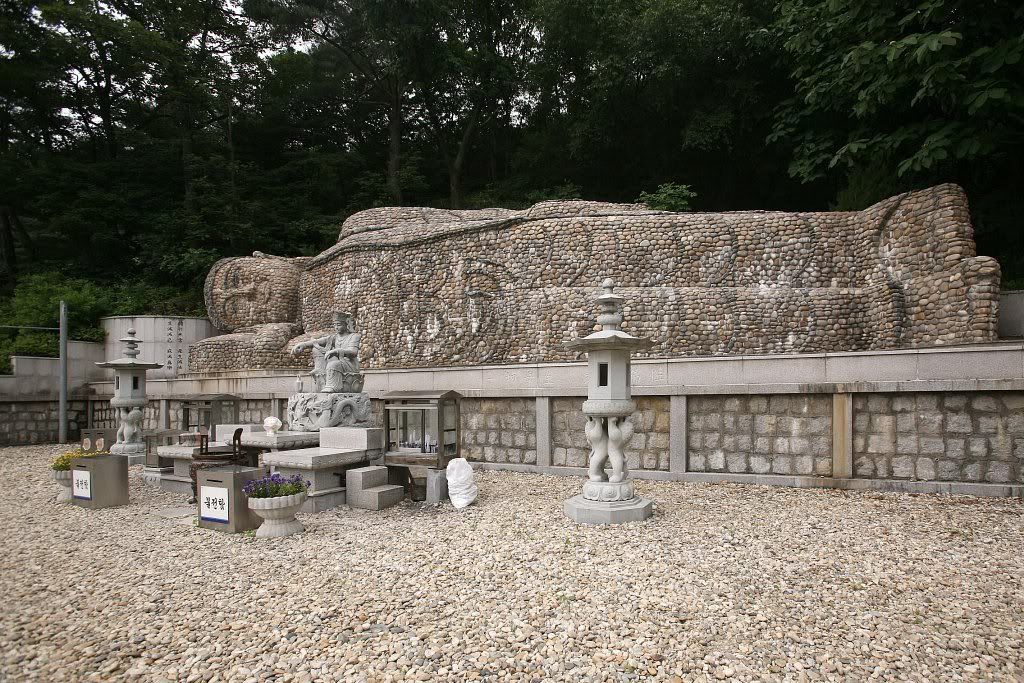

In order to extend our hike (Our route over Cheonggyesan took only about 3 and a half hours) we passed Seoul Grand Park, Seoul Racecourse and cut over Umyonsan and back to our apartment. In total it took nearly 4 and a half sweaty, sticky hours as humidity was 100% and the temperature was close to 30.

Monday, June 30, 2008
Gwanak Mountain Part 2.
Here is a short video from a couple of weeks ago. Usually visibility from the mountain isn't very good but on this particular day Incheon airport, over 50km away, was quite clear.
I must apologise for the crapness of this video. I had some better shots but I deleted them to make space on my camera before I went to Hooters.
Gwanak Mountain Part 1
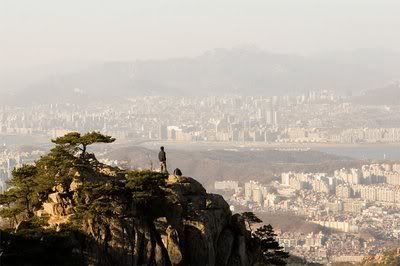
+

=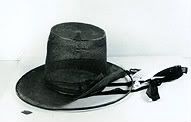

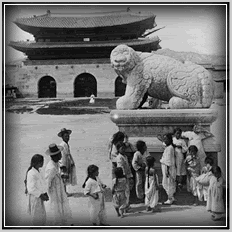

Originally established by one Master Uisang in 667 it has played host to many a dignitary, perhaps the most famous being Princes Yangnyong and Hyoryeong, who on hearing that their father, King Taejong (r. 1400-1418) had chosen their younger brother (and later Korea's most famous king) Sejong as the crown prince, took residence here in what can best be described as an adolescent huff.

Thursday, June 19, 2008
Umyonsan Part 2
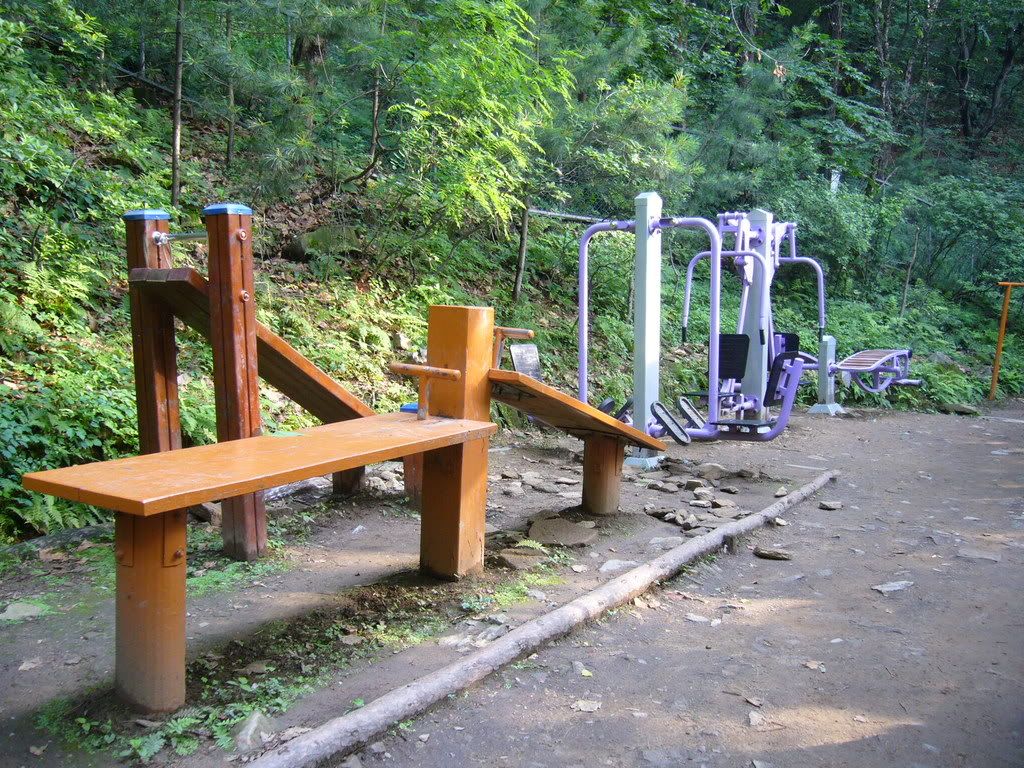
 Early mornings on the mountain can often resemble an episode from The Smurfs or a scene from Darby O' Gill and the Little People, as pint sized 아저씨and 아주머 scurry from one machine to the next, engaging in exercises that closely resemble the self abuse seen during Thaipusam.
Early mornings on the mountain can often resemble an episode from The Smurfs or a scene from Darby O' Gill and the Little People, as pint sized 아저씨and 아주머 scurry from one machine to the next, engaging in exercises that closely resemble the self abuse seen during Thaipusam.I had never seen a grandfather hang four feet off the ground by his ankles before I came to Korea, nor winced while watching a grandmother do bunny hops while holding a 20kg barbell across her shoulders - no time for warm ups in Korea, 빨리빨리.
"The Stairs of the 266 Steps"
This is not the name of the new Indiana Jones movie, rather one of the ways to reach the dizzying 298 meter peak of Umyonsan.
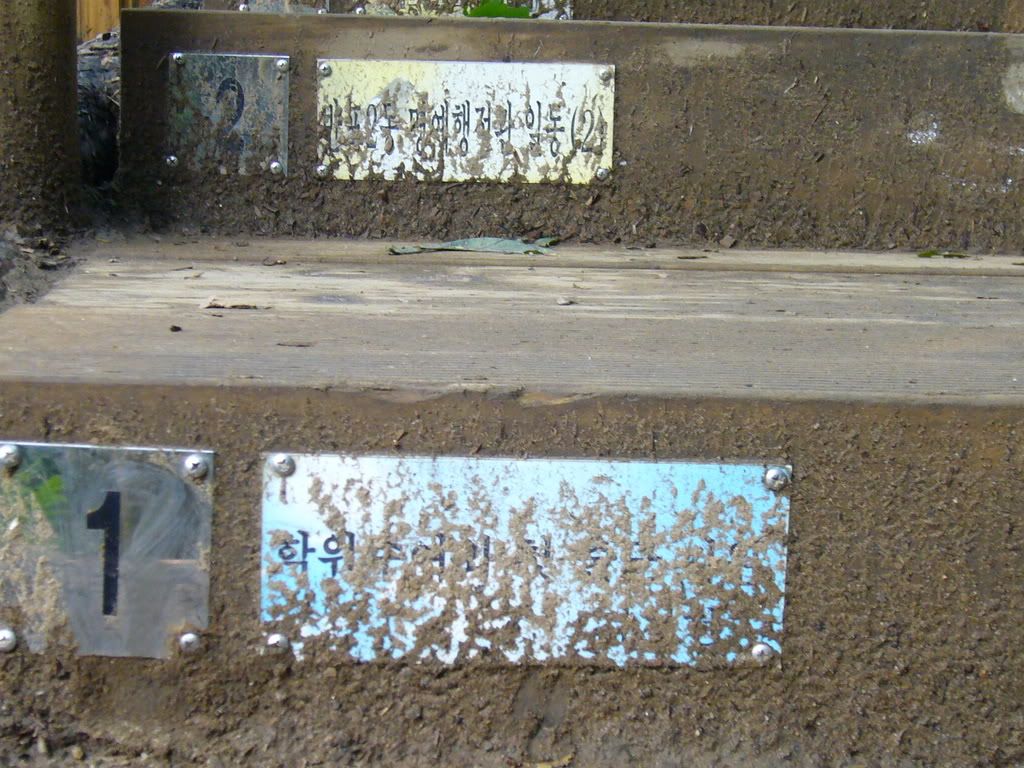
I know that this way might be cumbersome and unnecessary, considering the many other gentler ways to the top, but take it from someone in the know, it is worth it.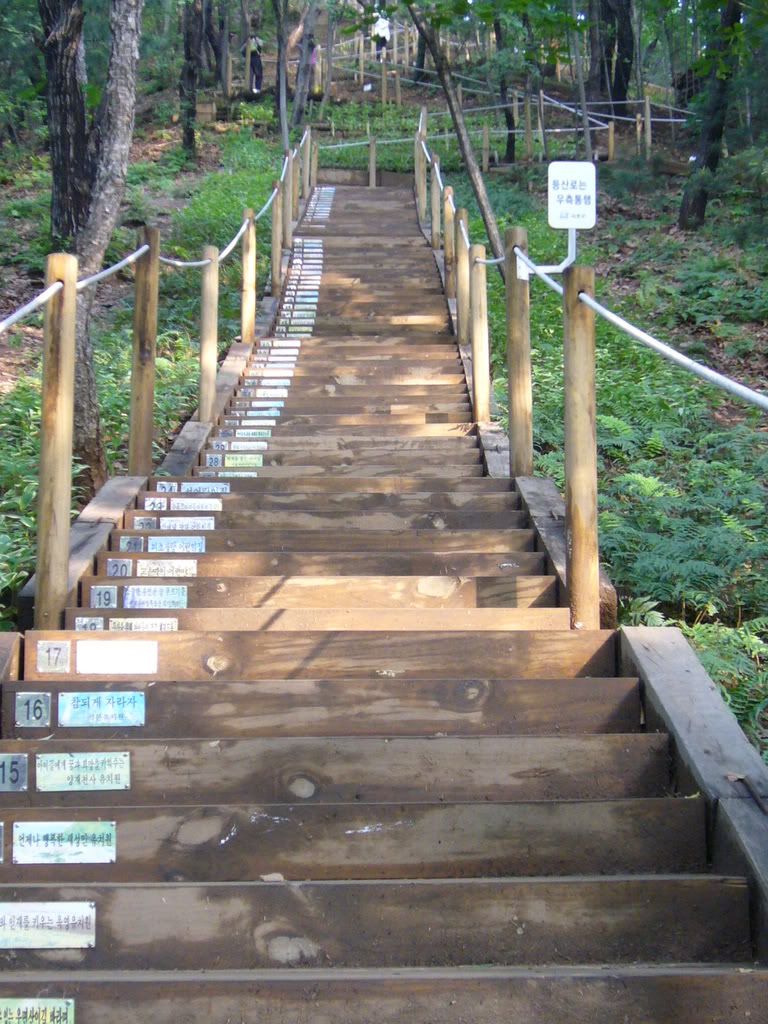
Keep going! Ignore the fact that your knees are creaking and your calves feel as if the are going to explode.
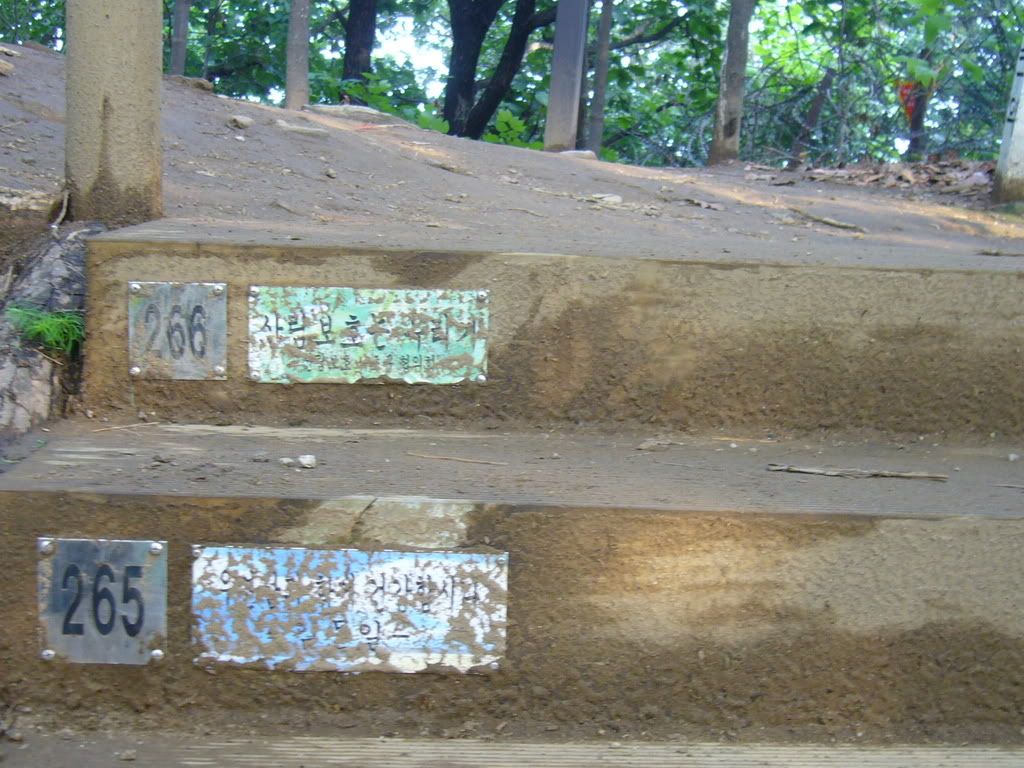
Push through the pain barrier! Ignore the fact that your head is spinning and your vision is blurry.
You see! Didn't I tell you it would be worth it! Now you'll get a birds eye view of this magnificent city, a testament to the power of man, the shining light of Asia!

Bugger.

It's a sad fact of life. Stick 23 million people into one place and you are going to get smog. It could be worse though, it could be yellow dust.

(From here)
At the foot of the mountain there is a fantastic little temple called Daeseongsa.

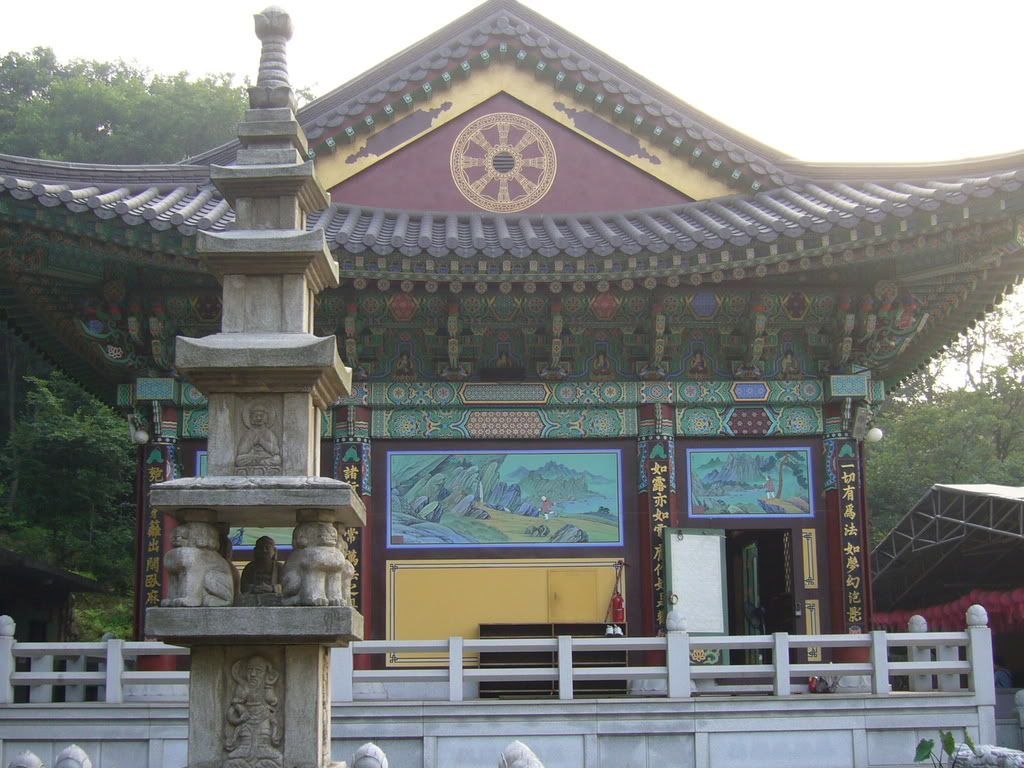
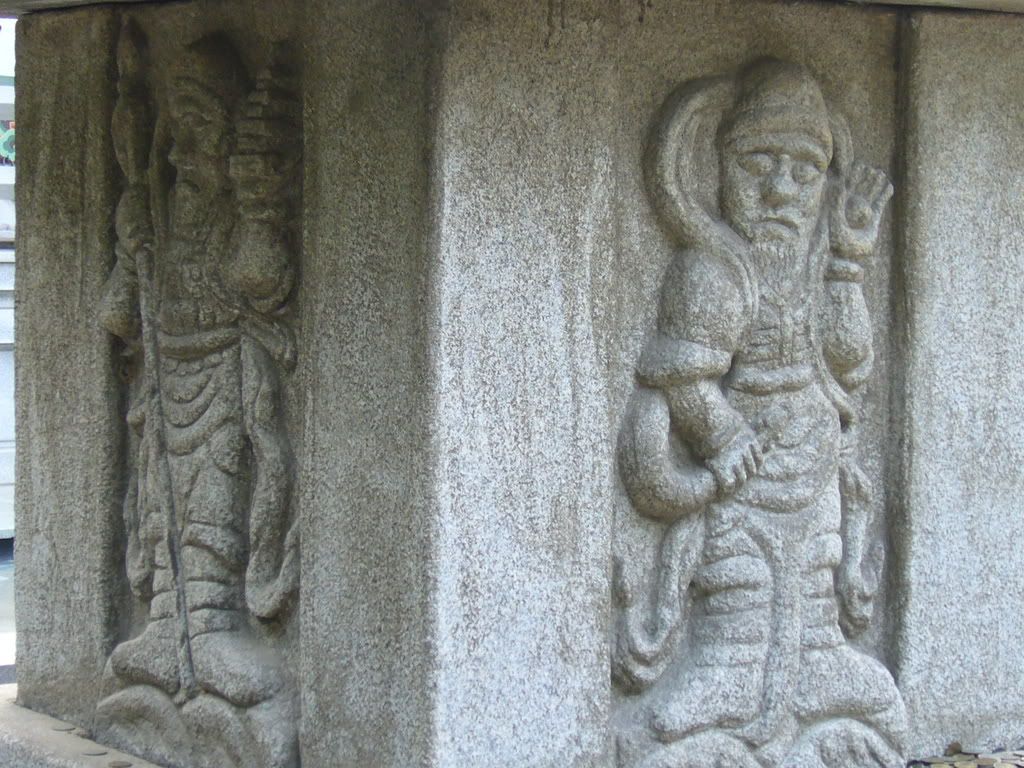
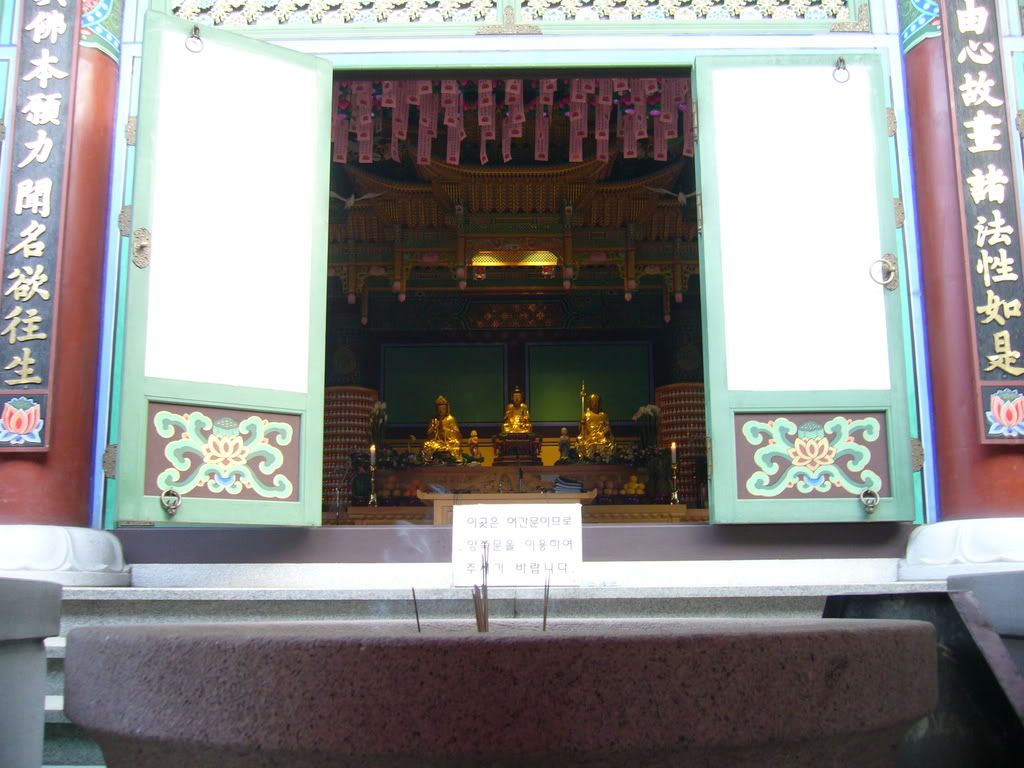
The famed Indian monk Malanada stayed here in 384. Feeling rather ill from the local cuisine and a tad homesick, he drank from the spring at this temple and was revived.
More recently it was the base for Baek Yong Seong, a monk and leader of the March 1st Independence Movement in 1919.
Monday, June 16, 2008
Umyonsan Part 1

We are very lucky living where we do. Within 20 minutes we have three excellent hills and mountains in easy reach.
One of the many great things about living in such a high population density city like Seoul are the ubiquitous recreational facilities. Wherever you live in the city, you are guaranteed not to be far away from a hill or mountain with a myriad of trails of varying degrees of difficulty. Most come equipped with fresh water springs, hidden badminton courts and most bizarrely. complete outdoor gyms. It was getting too dark to take many photos this evening but I will include some in the next post.

Koreans, on the whole, are a very fit bunch who exercise regularly, perhaps as a necessity owing to the fact that they consume biblical amounts of fatty pork belly and flavored ethanol on a regular basis. On weekends mountains are covered with hikers and mountain bikers, church groups and school groups, all looking for their little piece of paradise. Unfortunately, with a metropolitan population of over 20 million people, that is seldom the case and reaching the peaks of some mountains in the Seoul area can be less challenging than keeping your patience.
The closest mountain to us is Umyonsan, which means Sleeping Cow mountain. I've been reliably informed that this name comes from its elongated shape and not the crazy homeless woman who hangs out around the entrance. At just under 300 meters it isn't the most testing walk but does provide a great relief from screaming kids and smelly classrooms.

Umyeonsan is part of a range that runs across southern Seoul and was originally connected to Gwanaksan until an expressway was cut through connecting Seoul and Gwacheon.
Given its strategic location it is not surprising that the top of the mountain is occupied by a military installation and most of the northern slopes are covered with extensive trenches and machine gun emplacements and most exciting of all; a mine field.


These don't detract from what is a beautiful mountain. Replanted after the war, like most mountains in the South, and not incidentally, in the north, it has a rich mixture of deciduous and evergreen trees. Wildlife is every where and it is unusual not to see with pheasants, squirrels or woodpeckers, even close to the main trails.
In part 2 I'll include photos from the peak and something on Daeseonsa Temple.






